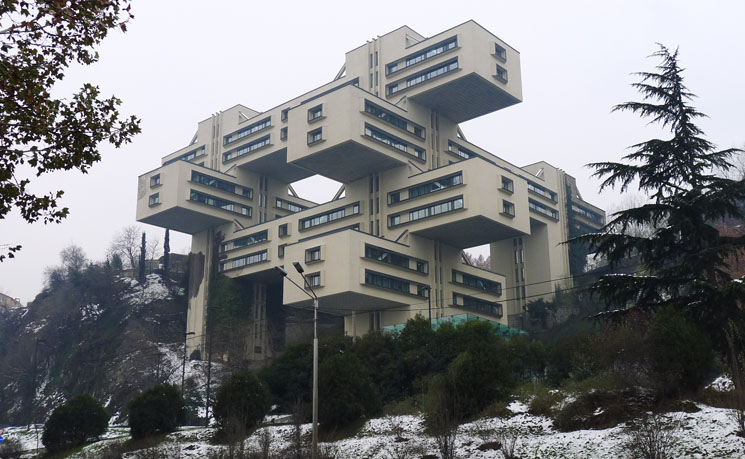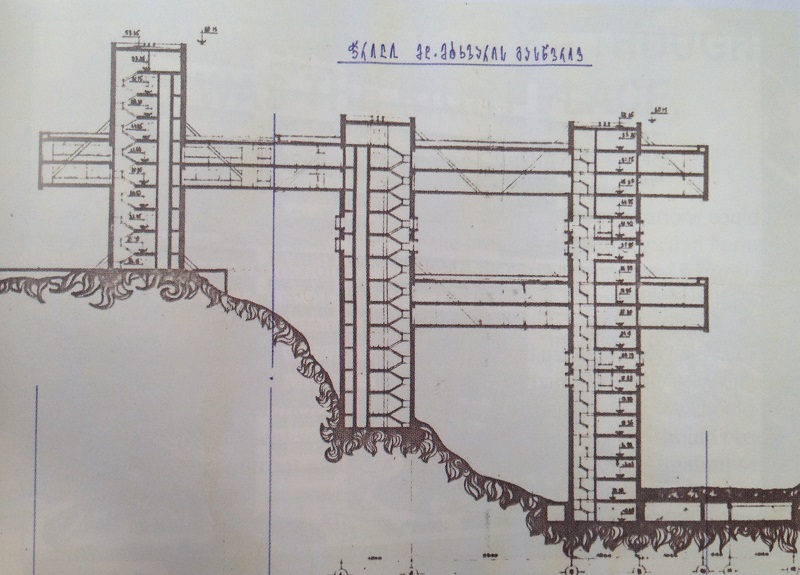Ministry of Transportation Building, Georgia
The former Ministry of Transportation Building in Tbilisi, Georgia, is a striking example of Communist design.
Architects George Chakhava and Zurab Jalaghania designed the building for the Ministry of Highway Construction of the Georgian Soviet Socialist Republic (SSR). Construction was completed in 1975.
The 18-storey building is notable for its unusual design which gives the impression of giant concrete blocks having been piled on top of one another at random. Built on a steep slope, three of the interlocking blocks are oriented on an east-west axis, while two are oriented on a north-south axis. The vertical circulation elements – stairs and lifts – are contained within three cores from which the rest of the structure hangs.
The harsh concrete façade and geometric form was inspired by the theories of the Russian constructivists, as well as the Brutalism movement and the Japanese Metabolists. Following an architectural concept known as the Space City method, parts of the building are raised above the ground, allowing the landscape to grow around and below it.
In 2007, the building was acquired by the Bank of Georgia who converted it into their headquarters, undertaking a major renovation, and installing a new glass cube entrance. In 2007, it was given Immovable Monument status under the National Monuments Act.
[edit] Related articles on Designing Buildings Wiki
- Abandoned movie theatres in Russia.
- Building of the week series.
- CCTV Headquarters.
- Constructivist architecture.
- Fuji TV Building, Tokyo.
- Habitat 67.
- La Grande Arche.
- Manchester Civil Justice Centre.
- Megastructure.
- Metabolism.
- Nakagin Capsule Tower.
- Owen Hatherley - Landscapes of Communism.
- Palace of Culture and Science.
- Robot Building, Bangkok.
- Scottish Parliament Building.
- Spomeniks.
- The Bierpinsel, Berlin.
- Unusual building design of the week.
[edit] External references
Featured articles and news
Homes England creates largest housing-led site in the North
Successful, 34 hectare land acquisition with the residential allocation now completed.
Scottish apprenticeship training proposals
General support although better accountability and transparency is sought.
The history of building regulations
A story of belated action in response to crisis.
Moisture, fire safety and emerging trends in living walls
How wet is your wall?
Current policy explained and newly published consultation by the UK and Welsh Governments.
British architecture 1919–39. Book review.
Conservation of listed prefabs in Moseley.
Energy industry calls for urgent reform.
Heritage staff wellbeing at work survey.
A five minute introduction.
50th Golden anniversary ECA Edmundson apprentice award
Showcasing the very best electrotechnical and engineering services for half a century.
Welsh government consults on HRBs and reg changes
Seeking feedback on a new regulatory regime and a broad range of issues.
CIOB Client Guide (2nd edition) March 2025
Free download covering statutory dutyholder roles under the Building Safety Act and much more.
Minister quizzed, as responsibility transfers to MHCLG and BSR publishes new building control guidance.
UK environmental regulations reform 2025
Amid wider new approaches to ensure regulators and regulation support growth.
BSRIA Statutory Compliance Inspection Checklist
BG80/2025 now significantly updated to include requirements related to important changes in legislation.
























